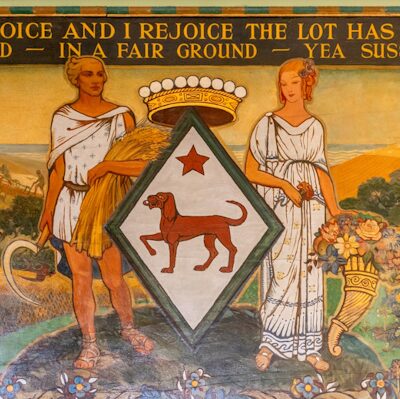Tom Hasson on Sussex’s hidden treasures #3

Up the stairs at Hove Library, above the entrance to the Wolseley Room, lies a striking but overlooked mural, The Spirit of Agriculture. Painted in 1925 by Hove artist Gwynned Hudson, this is more than just a decorative piece. It is a vibrant work of art that speaks of the deep-rooted farming heritage of Sussex and the ideals of learning and labour that shaped the region.
At the heart of the mural is a symbolic representation of agriculture and horticulture, industries that have sustained Sussex for centuries. Framed by the South Downs, which expand towards a distant shoreline, it presents an idealised landscape, where rolling fields and golden harvests stretch out under a clear sky. Two classical figures – a man with a scythe and a woman carrying a cornucopia – stand as allegories of labour and cultivation, embodying the importance of working the land. In an era of increasing urbanisation, the mural served as both a celebration of rural life and a reminder of the toil behind the food that sustained Britain.
Inscribed at the top, there’s a line from Rudyard Kipling’s 1902 poem Sussex:
Each to his choice, and I rejoice
The lot has fallen to me
In a fair ground – in a fair ground
Yea, Sussex by the sea
These words encapsulate the deep pride and connection felt by those who call Sussex home, a sentiment that resonates through Hudson’s sweeping rural tableau. This Sussex pride was felt keenly by Frances Garnet Wolseley, who commissioned the mural – made clear by the coat of arms for the Viscountcy of Wolseley at the work’s centre, featuring a red Talbot dog. She was a dedicated advocate for agricultural education, starting the Glynde College for Lady Gardeners in 1902 and publishing multiple successful books on the subject. The inscription below the painting declares her vision:
This room is dedicated to our two oldest and greatest industries, Agriculture and Horticulture, without which man cannot live… It is the humble desire of the donor… that within these walls, the children of cities and towns will by study gain an understanding of the arduous work that is done by those who till the soil and grow our food.
Gwynned Hudson, a talented painter and illustrator, is best known for her intricately detailed editions of Alice’s Adventures in Wonderland (1922) and Peter Pan (1930), who, along with her sister Dorothy, was a key figure in Hove’s artistic community. The sisters operated from Wick Studio on Holland Road, where they not only pursued their own artistic endeavours but also taught drawing, painting, design, embroidery, book illustration, and more, offering private lessons. In 1916, an exhibition at Hove Library showcased their decorative drawings and book illustrations, attracting over 2,500 visitors. Gwynedd also contributed illustrations for London Underground posters, solidifying her reputation as a versatile and accomplished artist on the national stage.
While her illustrations garnered widespread recognition across Britain, Hudson’s legacy in Sussex is profoundly embodied in this evocative mural – one of her few known large-scale works. Her ability to intertwine symbolism, local pride, and artistic elegance in The Spirit of Agriculture underscores her prowess as a muralist and her deep appreciation for the Sussex landscape.
Particularly striking is the symbolic imagery carried by the two central figures. The male figure holds a scythe, a traditional farming tool long associated with the cycle of harvest and renewal. Beyond its practical function, the scythe carries deeper meanings, often representing the passage of time and the inevitability of change (it’s no coincidence that the Greek god of agriculture, who is always depicted carrying a scythe, is named Cronos, their word for time being ‘chronos’). The scythe serves as a reminder that agriculture is a timeless, cyclical and ever evolving practice, essential to human survival.
The Ceres-like female figure carries a cornucopia, or ‘horn of plenty’, overflowing with produce. This ancient symbol of abundance and nourishment signifies prosperity and the rewards of hard work. Its presence reinforces the message that agricultural labour sustains not only individuals but entire communities. The contrast between the scythe and the cornucopia – one representing effort and the other its rewards – captures the fundamental balance of agricultural life.
Though now a century old, The Spirit of Agriculture holds relevance today. In an age where food production is distanced from daily life, Hudson’s mural reminds us of the enduring significance of agriculture. It also reflects broader themes of sustainability, stewardship, and local identity – issues that remain as pressing now as they were in 1925. Its location is also key. Hove Library is a Carnegie Library, founded by the philanthropist Andrew Carnegie on the principle of free public access to knowledge. And, as the inscription explicitly states, through study comes understanding. While Hudson’s mural specifically relates to the importance of education about agriculture, it also highlights the educationally and culturally nourishing role of libraries more generally.
Despite their undeniable value, libraries in Brighton & Hove are facing significant challenges. Recent reports indicate that three community libraries may close as part of savings plans by the council, with the opening hours of central libraries possibly being reduced. It’s a sadly familiar story.
These potential closures threaten the role of libraries as hubs of education and community engagement. As The Spirit of Agriculture was designed to teach future generations about the importance of agriculture, so too do libraries serve as a place for the study and preservation of local history. Protecting these spaces is about more than just books – it’s about maintaining the cultural fabric that connects communities to their past and shapes their future.
Hidden in plain sight, Gwynned Hudson’s remarkable mural invites visitors to pause and appreciate the artistry of her work, the deep traditions that continue to shape Sussex and the vital role of libraries in preserving knowledge, culture, and community, ensuring that future generations remain connected to their heritage and the land that sustains them.
